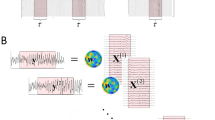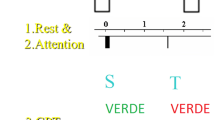Abstract
Single-trial analysis of human electroencephalography (EEG) has been recently proposed for better understanding the contribution of individual subjects to a group-analyis effect as well as for investigating single-subject mechanisms. Independent Component Analysis (ICA) has been repeatedly applied to concatenated single-trial responses and at a single-subject level in order to extract those components that resemble activities of interest. More recently we have proposed a single-trial method based on topographic maps that determines which voltage configurations are reliably observed at the event-related potential (ERP) level taking advantage of repetitions across trials. Here, we investigated the correspondence between the maps obtained by ICA versus the topographies that we obtained by the single-trial clustering algorithm that best explained the variance of the ERP. To do this, we used exemplar data provided from the EEGLAB website that are based on a dataset from a visual target detection task. We show there to be robust correpondence both at the level of the activation time courses and at the level of voltage configurations of a subset of relevant maps. We additionally show the estimated inverse solution (based on low-resolution electromagnetic tomography) of two corresponding maps occurring at approximately 300 ms post-stimulus onset, as estimated by the two aforementioned approaches. The spatial distribution of the estimated sources significantly correlated and had in common a right parietal activation within Brodmann’s Area (BA) 40. Despite their differences in terms of theoretical bases, the consistency between the results of these two approaches shows that their underlying assumptions are indeed compatible.





Similar content being viewed by others
References
Barbati G, Sigismondi R, Zappasodi F, Porcaro C, Graziadio S, Valente G, Balsi M, Rossini PM, Tecchio F (2006) Functional source separation from magnetoencephalographic signals. Hum Brain Mapp 27:925–934
Bell AJ, Sejnowski TJ (1995) An information-maximization approach to blind source separation and blind deconvolution. Neural Comput 7(6):1129–1159
Belouchrani A, Abed-Merain K, Cardoso J-F, Moulines E (1997) A blind source separation technique using second-order statistics. IEEE Trans Signal Process 5:434–444
Bishop CM (1995) Neural networks for pattern recognition. Oxford University Press, Oxford
De Lucia M, Michel CM, Clarke S, Murray MM (2007a) Single subject EEG analysis based on topographic information. Int J Bioelectromagn 9(3):168–171
De Lucia M, Michel CM, Clarke S, Murray MM (2007b) Single-trial topographic analysis of human EEG: a new ‘image’ of event-related potentials. In: Proceedings of the IEEE/EMBS region 8 international conference on information technology applications in biomedicine, ITAB, art. no. 4407353, pp 95–98
De Lucia M, Fritschy J, Dayan P, Holder DS (2008) A novel method for automated classification of epileptiform activity in the human electroencephalogram-based on independent component analysis. Med Biol Eng Comput 46(3):263–272
Debener S, Makeig S, Delorme A, Engel AK (2004) What is novel in the novelty oddball paradigm? Functional significance of the novelty P3 event-related potential as revealed by independent component analysis. Cogn Brain Res 22(3):309–321
Dempster A, Laird N, Rubin D (1977) Maximum likelihood from incomplete data via the EM algorithm (with discussion). J R Stat Soc B 39:1–38
Georgiadis SD, Ranta-aho PO, Tarvainen MP, Karjalainen PA (2005) Single-trial dynamical estimantion of event-related potentials: a kalman filter-based approach. IEEE Trans Biomed Eng 52(8):1397–1406
Guthrie D, Buchwald JS (1991) Significance testing of difference potentials. Psychophysiology 28:240–244
Knuth KH, Shah AS, Truccolo WA, Ding M, Bressler SL, Schroeder CE (2006) Differentially variable component analysis: identifying multiple evoked components using trial-to-trial variability. J Neurophysiol 95:3257–3276
Lehmann D (1987) Principles of spatial analysis. In: Gevins AS, Remond A (eds) Handbook of electroencephalography and clinical neurophysiology, vol 1: methods of analysis of brain electrical and magnetic signals. Elsevier, Amsterdam, pp 309–354
Makeig S, Westerfield M, Jung TP, Covington J, Townsend J, Sejnowski TJ, Courchesne E (1999) Functionally independent components of the late positive event-related potential during visual spatial attention. J Neurosci 19(7):2665–2680
Makeig S, Westerfield M, Jung T-P, Enghoff S, Townsend J, Courchesne E, Sejnowski TJ (2002) Dynamic brain sources of visual evoked responses. Science 295:690–694
Michel CM, Thut G, Morand S, Khateb A, Pegna AJ, Grave de Peralta R, Gonzales S, Seeck M, Landis T (2001) Electric source imaging of human brain functions. Brain Res Rev 36:108–118
Michel CM, Murray MM, Lantz G, Gonzalez S, Grave de Peralta R (2004) EEG source imaging. Clin Neurophysiol 115:2195–2222
Murray MM, Brunet D, Michel CM (2008) Topographic ERP analyses: a step-by-step tutorial review. Brain Topogr 20:249–264
Naeem M, Brunner C, Leeb R, Graimann B, Pfurtscheller G (2006) Separability of four-class motor imagery data using independent components analysis. J Neural Eng 3:208–216
Pascual-Marqui RD, Michel CM, Lehmann D (1994) Low resolution electromagnetic tomography: a new method for localizing electrical activity in the brain. Int J Psychophysiol 18:49–65
Pourtois G, Delplanque S, Michel C, Vuilleumier P (2008) Beyond conventional event-related brain potential (ERP): exploring the time-course of visual emotion processing using topographic and principal component analyses. Brain Topogr 20(4):265–277
Quiroga RQ, Garcia H (2003) Single trial event-related potentials with wavelet denoising. Clin Neurophys 114:376–390
Talairach J, Tournoux P (1988) Co-planar stereotaxic atlas of the human brain. Thieme, New York
Tang AC, Sutherland MT, McKinney CJ (2005) Validation of SOBI components from high density EEG. Neuroimage 25:539–553
Vigario RN (1997) Extraction of ocular artefacts from EEG using independent component analysis. Electroencephal Clin Neurophysiol 103:395–404
Tzovara A, Murray MM, Plomp G, Herzog M, Michel CM, De Lucia M (2010) Event-related potential analyses via single-subject topographic classification. Neuroimage (in revision)
Acknowledgements
This work has been supported by the Swiss National Science Foundation (grant #K-33K1_122518/1). We thank Athina Tzovara for comments on previous versions of this manuscript.
Author information
Authors and Affiliations
Corresponding author
Additional information
This is one of several papers published together in Brain Topography on the ‘‘Special Topic: Cortical Network Analysis with EEG/MEG’’.
Rights and permissions
About this article
Cite this article
De Lucia, M., Michel, C.M. & Murray, M.M. Comparing ICA-based and Single-Trial Topographic ERP Analyses. Brain Topogr 23, 119–127 (2010). https://doi.org/10.1007/s10548-010-0145-y
Received:
Accepted:
Published:
Issue Date:
DOI: https://doi.org/10.1007/s10548-010-0145-y




